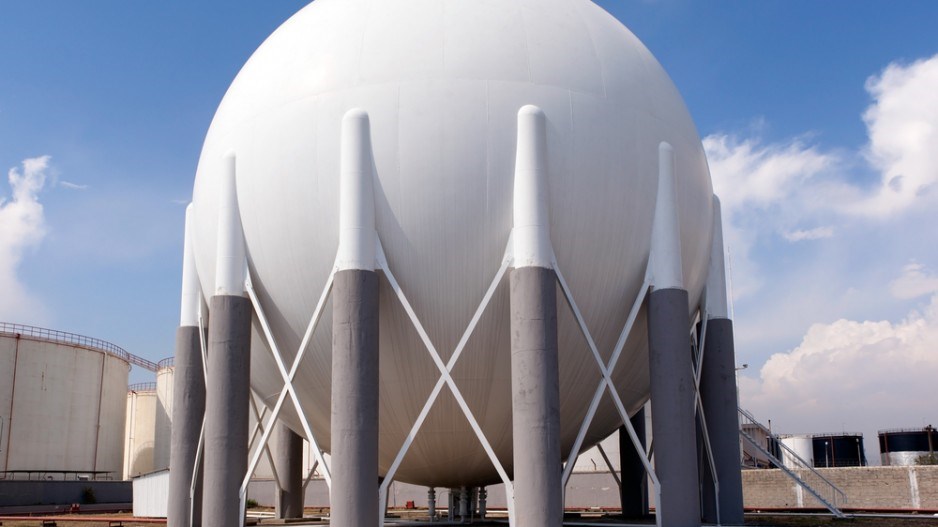Western Canada’s natural gas production will grow by about 5 billion cubic feet (bcf) a day by 2022 if at least the equivalent amount of LNG is exported.
But without LNG exports, gas output will be flat, says Simon Mauger, director of natural gas supply and economics at Ziff Energy, a division of HSB Solomon Associates LLC.
“Growth in Western Canada will depend on market growth, first and foremost. So no LNG exports, no growth,” Mauger said in an interview. “With the LNG exports, we expect to see quite some growth — from about 14 bcf a day today up to 19 bcf a day in 2022.”
That would exceed Western Canada’s previous production record of about 17 bcf a day. The peak for the entire country was 18 bcf a day.
The growth prediction — which assumes two, possibly three, LNG plants will be onstream with combined exports of 5.7 bcf equivalent a day during 2022 — is contained in Ziff Energy’s recently completed forecast, Western Canada Natural Gas Production Outlook To 2022.
Ziff expects the overseas exports will start just before 2020 and continue to ramp up through 2022 as new LNG trains are added.
The volume of gas Ziff expects to be exported as LNG in 2022 — 5.7 bcf a day — is more than double the 2.8 bcf a day forecast to be exported in 2020, Mauger said.
Two-plus bcf a day from the Duvernay
By 2022, gas from shales and other tight formations will account for at least 80% of Western Canada’s gas output, up from more than 50% now, Mauger said.
Mauger said the Montney and Duvernay plays are key to Ziff’s forecast growth with combined average daily output of 10 bcf a day in 2022.
For the Montney, the consultancy is predicting strong production growth in the liquids-rich areas and somewhat slower growth in the dryer areas until the LNG projects come onstream.
The Ziff forecast expects production from the Duvernay formation to average between two bcf and three bcf a day in 2022, though Mauger cautioned the ramp-up from that emerging liquids-rich shale play will depend on commerciality.
He estimates today’s Duvernay production is somewhere around 300 million cubic feet (mmcf) a day.
“I think the north Duvernay is pretty close to commercial, if not there,” he said, noting that the next round of drilling in the north Duvernay is pad based. “The south Duvernay, I believe, is still not past a commerciality test.”
Encana Corporation has already deemed its liquids-rich Duvernay plays in the Kaybob and Simonette areas commercial.
Mauger estimates the south Duvernay is a year or two behind the north Duvernay in terms of evaluation: “So far, some of the results look reasonably encouraging. We do need to see some improvements in both costs and recoveries in order for it to be commercial. But there’s reason for optimism.”
He expects recoveries will improve over time as companies optimize the completion programs.
Meanwhile, the Horn River and Liard plays are expected to have combined average production of just over two bcf a day in 2022, Ziff forecasts.
Both of these plays are dry gas, so without the liquids to bolster the economics neither is expected to have significant production until LNG exports begin.
Both the Horn River and Liard involve deep, high-pressure reservoirs with huge reserves per well, but the wells are expensive. Mauger said there is also a very limited number of rigs capable of drilling horizontal wells in plays such as the Liard and this could also limit the pace of development.
A year ago Trinidad Drilling Ltd. signed a contract to build one of Canada’s largest and most technically advanced land-based rigs to drill for Liard gas.
Oilsands can’t offset U.S. drop
Without LNG exports, the outlook for Alberta’s gas patch is grim.
While growth in the Alberta oilsands has increased gas demand by almost a bcf a day over the past eight years or so, gas exports to the U.S. have fallen by three or four bcf a day in the same period, Mauger said.
Meanwhile, Ziff expects gas from the Marcellus and the Utica shale plays in the U.S. Northeast will continue to flow into Quebec, Ontario and possibly even Manitoba, displacing Western Canadian gas.
“Mostly we consider southern Ontario is the key market area for Marcellus and Utica gas. But there are possibly times where we might see that gas push into northern Ontario and even Manitoba,” Mauger said.
IPs more than doubled
The good news is the enormous increase in the average productivity in western Canadian gas wells.
Last year, the average initial production (IP) rate was almost triple the 2011 level due to the increase in horizontal drilling and multi-stage hydraulic fracture completions, Ziff reported.
In 2011, the average IP rate of gas wells drilled in Western Canada was only about 500,000 cubic feet a day. Last year, that was 1.3 mmcf a day, Ziff found.
“And the reason for that is the drilling that’s taking place — both today and over the rest of the decade — is going to be in the high-productivity areas” such as the Deep Basin, Mauger said.




